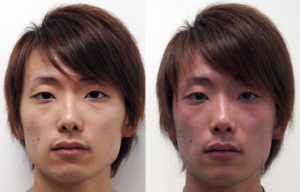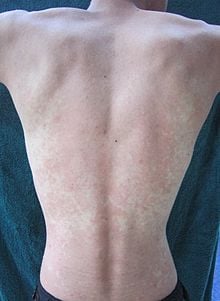How To Get Rid Of Red Face From Alcohol
What is Alcohol Flush Reaction?
Alcohol flush reaction, or alcohol flush syndrome, refers to a bodily response to drinking alcohol characterized by the red flushing of the face and skin. It a primary indicator of alcohol intolerance.

When you drink alcohol, your body breaks down the ethanol in the liver with an enzyme called Alcohol Dehydrogenase (ADH). It transforms the ethanol into a toxic compound called Acetaldehyde (CH3CHO), a known carcinogen.
Then, another enzyme called Aldehyde Dehydrogenase 2 (ALDH2) quickly breaks down the Acetaldehyde into a less-toxic compound known as Acetate (CH3COO-).
Acetate is further broken down into carbon dioxide and water.
This is a natural process that your body does — or should do — on its own. Unfortunately, not everyone's bodies can do this efficiently.
Alcohol flush syndrome is an inherited metabolic disorder. It causes the body difficulty when metabolizing the Acetaldehyde compound. Acetaldehyde accumulates in the blood, resulting in red flushing, or spots, on the skin.
ALCOHOL REHAB HELP
Alcohol Treatment Near You
Rehabilitation Services To Help You Overcome Your Alcohol Use Disorder. Alcohol Rehab Help Has Specialized Drug And Alcohol Rehab Facilities Across The U.S.
Call now (855) 772-9047
How Common is Alcohol Intolerance?
One study estimates that approximately 8% of the population, or 540 million people have alcohol flushing syndrome.
Some demographics of people are at a higher risk, such as East Asian populations and people of Asian descent. Approximately 36 percent of East Asians (Japanese, Chinese, and Koreans) show a physiological response to drinking alcohol that includes a flushing reaction.
That's why alcohol flush is sometimes referred to as "Asian flush" and "Asian glow."
What Causes Alcohol Flush Reaction?
Alcohol intolerance is caused by a genetic variant or mutation in the ALDH2 enzyme. This makes it unable to break down the toxic byproduct Acetaldehyde efficiently. ALDH2 deficiency can also affect your alcohol metabolism.
When the body's ALDH2 gene doesn't operate as well as it should, it can cause an alcohol flush response.
If the ALDH2 enzyme does not break down Acetaldehyde, it builds up in the blood. This can cause flushed skin, a rapid heartbeat, high blood pressure, and other symptoms of alcohol flush.
While the symptoms of alcohol flush might not sound severe, alcohol flush can have a serious impact on someone's life. Facial flushing is associated with an increased risk of cancer in men in East Asia. This is especially true for esophageal cancer.
While the cancer risk doesn't seem to be higher for women, anyone who deals with alcohol flushing should seek advice from health care professionals about maintaining their health.
ALCOHOL REHAB HELP
Find Help For Your Addiction
You don't have to overcome your addiction alone. Professional guidance and support is available. Begin a life of recovery by reaching out to a specialist today.
Call now (855) 772-9047
Symptoms of Alcohol Flushing
The most common symptom of alcohol is facial flushing. The face turns red and makes it look like you just exercised or stood outside in the cold for too long. Other parts of the body that may be affected include your chest and back.
Alcohol flush can look and feel uncomfortable. And the other symptoms that can occur with this kind of reaction to alcohol can be much worse.

Other side effects of alcohol flushing include the following:
- Reddening skin in other areas of the body
- Increased heart rate
- Overheating sensation
- Headache
- Dizziness
- Nausea with or without vomiting
- Horrible hangovers
- Weight gain
Alcohol Intolerance vs Alcohol Allergy
Many people confuse alcohol intolerance, or an alcohol flush reaction with an alcohol allergy. Alcohol intolerance is a genetic metabolic disorder. Alcohol allergy is a rare immune system response to alcohol.
Alcohol allergy is when your body treats alcohol as an allergen or pollutant. Symptoms range from mild to severe. People with a true alcohol allergy should avoid drinking altogether.
Anaphylaxis (a life-threatening allergic reaction) is the worst potential effect.
Other side effects of alcohol allergy include:
- Hives, eczema, or itchy skin
- Swollen face, throat, or other areas of the body
- Itching mouth, nose, or eyes
- Difficulty breathing or congestion
- Nausea, vomiting, abdominal pain, or diahrrea
- Light headedness, dizziness, or loss of conscioussness
You can also be allergic to other ingredients in alcoholic drinks. Common ingredients that may cause an allergic reaction include:
- Grapes
- Wheat
- Rye
- Barley
- Yeast
Can You Diagnose Alcohol Flush Syndrome
Yes, a doctor will use an ethanol patch test to diagnose you for alcohol flush syndrome. This is a simple test and an effective indicator of the ALDH gene variation/mutation that causes alcohol intolerance.
The doctor will place a small amount of ethanol on some gauze and press it against your arm. After approximately seven minutes, the doctor will remove the gauze and check to see if your skin is red, itchy, or swollen.
Treatment for Alcohol Flush Reaction
Unfortunately, there is no cure for alcohol flush reactions. The best way to prevent it is to avoid alcohol completely.
By not drinking alcohol, your body isn't tasked with breaking down the toxic compounds that cause alcohol flush reaction.
However, if you do choose to drink, here are some tips to help manage or minimize alcohol flush reactions:
- Limit the amount of alcohol you consume in a given time
- Limit how often you consume alcohol (only drink alcohol during special occasions, for example)
- Choose alcoholic beverages with lower alcohol contents
- Practice breathing and relaxation techniques to help calm your heart rate and other symptoms of alcohol flush
- Stay hydrated to help minimize the intensity of certain alcohol flush symptoms like overheating, nausea, and hangovers
Common Questions and Answers
Alcohol flush reactions can be alarming, especially if you've never had one before. Here are answers to some of the most commonly asked questions about alcohol flush reaction.
How do you stop an alcohol flush reaction?
While there is no cure for alcohol flush, avoiding alcohol consumption will prevent you from having a reaction. You can also limit your alcohol intake, reduce the frequency of your alcohol intake, and choose alcoholic drinks that have less alcohol content to better cope with alcohol flush reactions.
Is a red face a sign of alcoholism?
Yes, flushed skin, such as a red face, may reveal alcoholism. While a red face is not always a sign of alcoholism, it is a possible symptom. If you or someone you know is struggling with alcoholism, seek help from a professional. There are plenty of treatment options available.
Is alcohol intolerance the same as being intoxicated?
Alcohol intolerance is not the same thing as being intoxicated. Not everyone who is intoxicated has an intolerance to alcohol. Getting intoxicated happens when alcohol hits the body, but how the body breaks down the alcohol determines whether or not you have alcohol intolerance.
Is alcohol intolerance the same as an alcohol allergy?
No, alcohol intolerance is not the same as an alcohol allergy. While alcohol intolerance is a genetic disorder that's caused by missing or dysfunctional enzymes in the body, an alcohol allergy is caused by an allergic reaction to what's in an alcoholic drink. Alcohol intolerance and an alcohol allergy may have similar symptoms.
How To Get Rid Of Red Face From Alcohol
Source: https://alcoholrehabhelp.org/addiction/alcohol-flush-reaction/#:~:text=Unfortunately%2C%20there%20is%20no%20cure,that%20cause%20alcohol%20flush%20reaction.
Posted by: hallrosed1985.blogspot.com

0 Response to "How To Get Rid Of Red Face From Alcohol"
Post a Comment